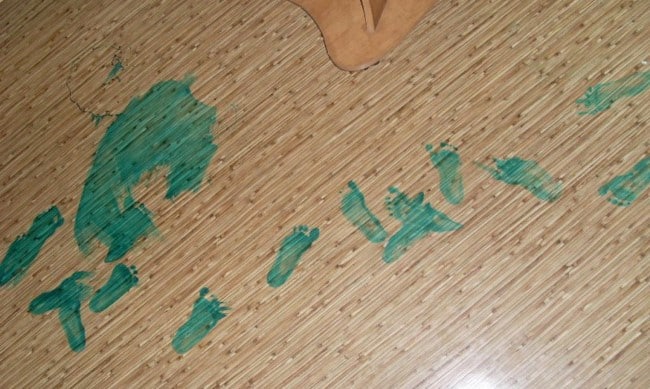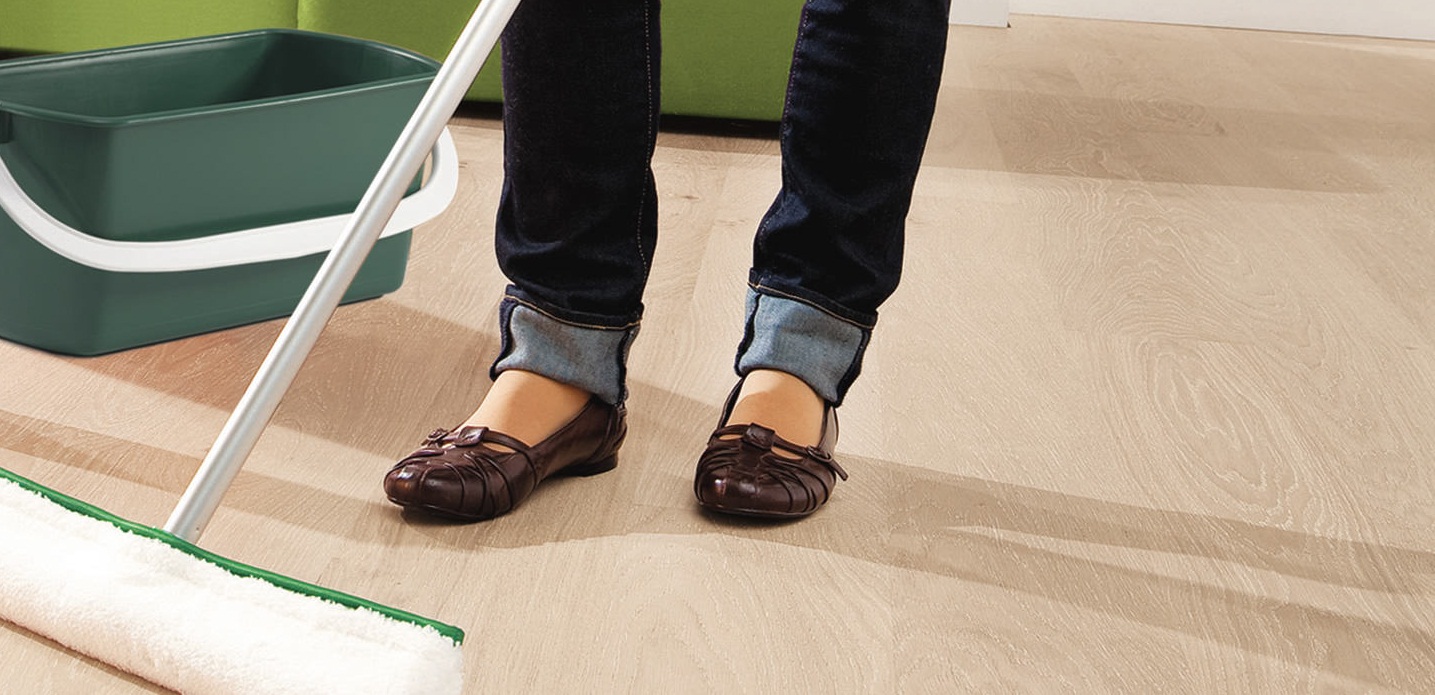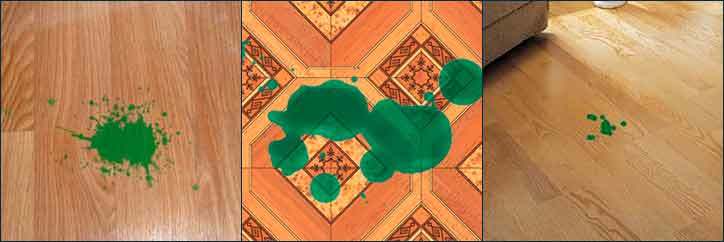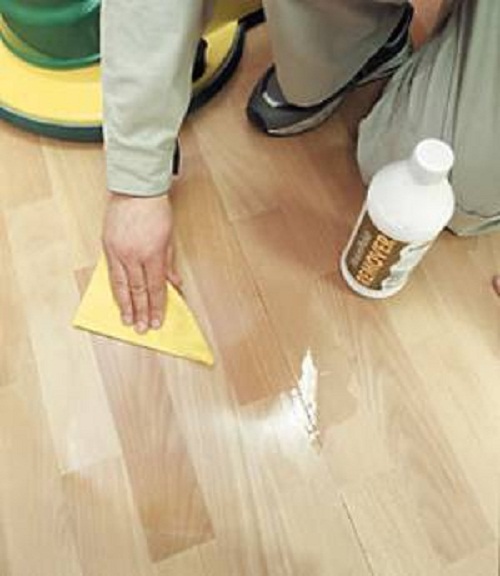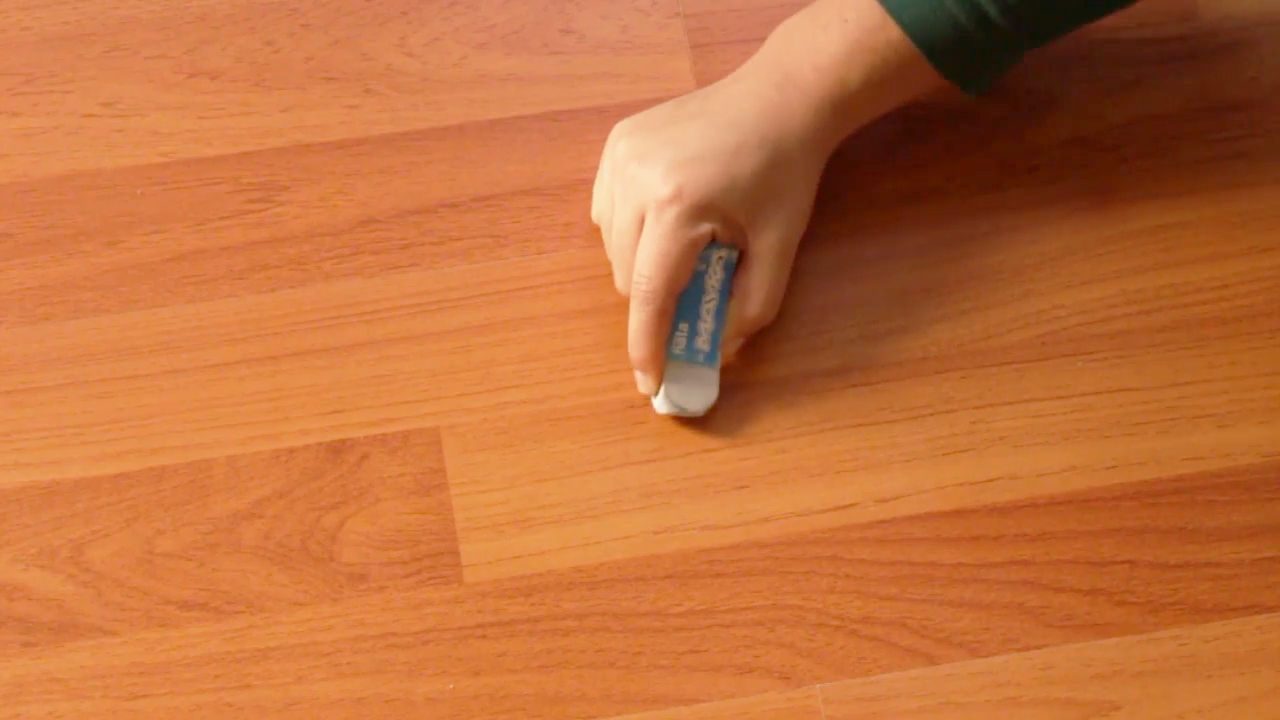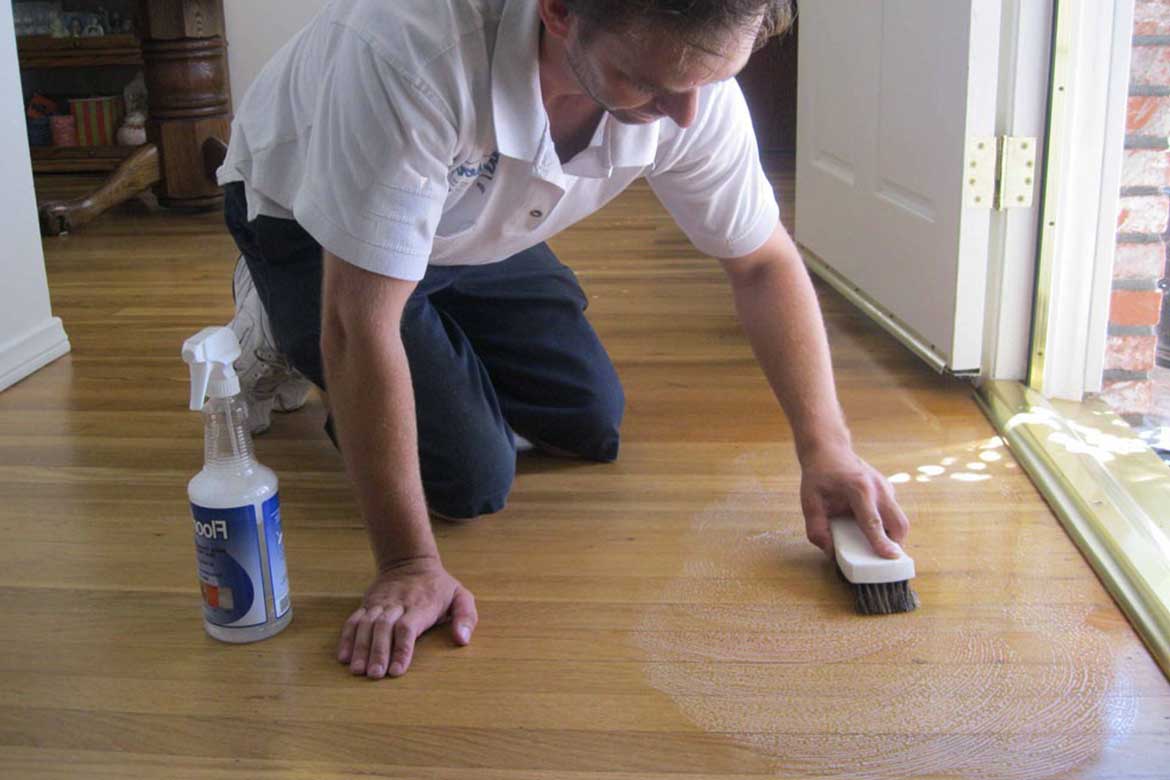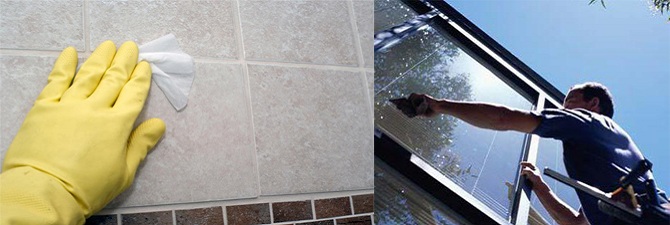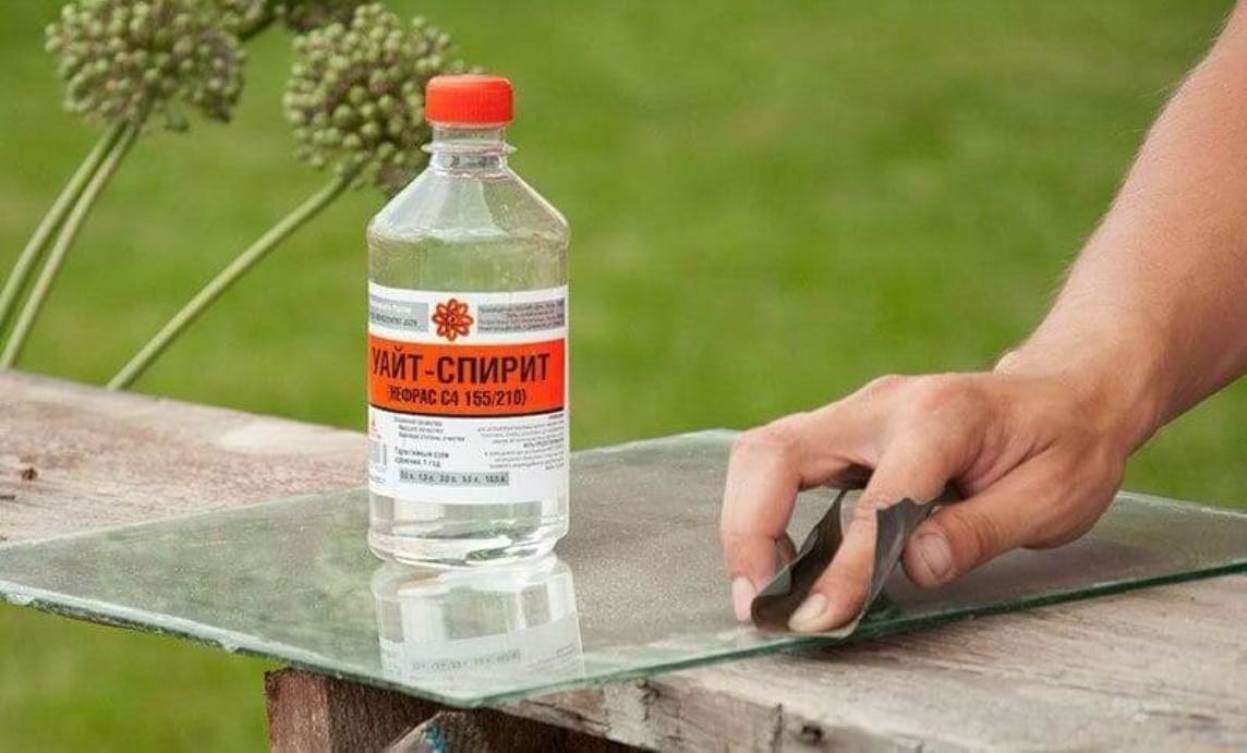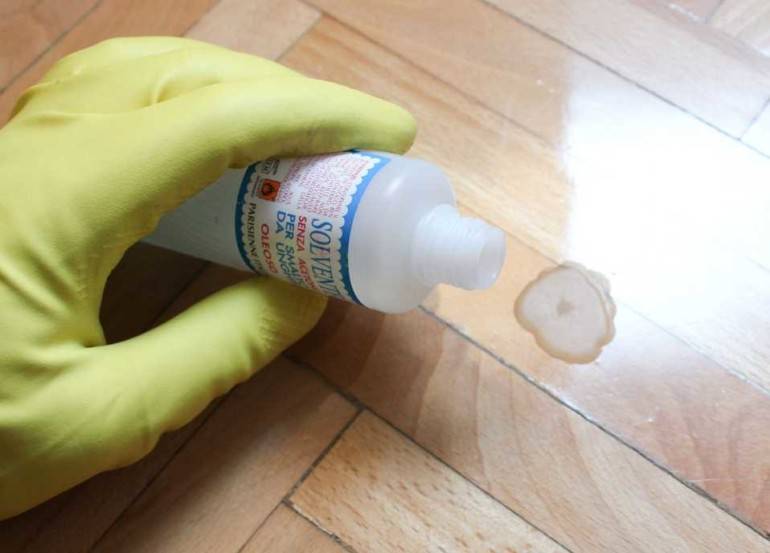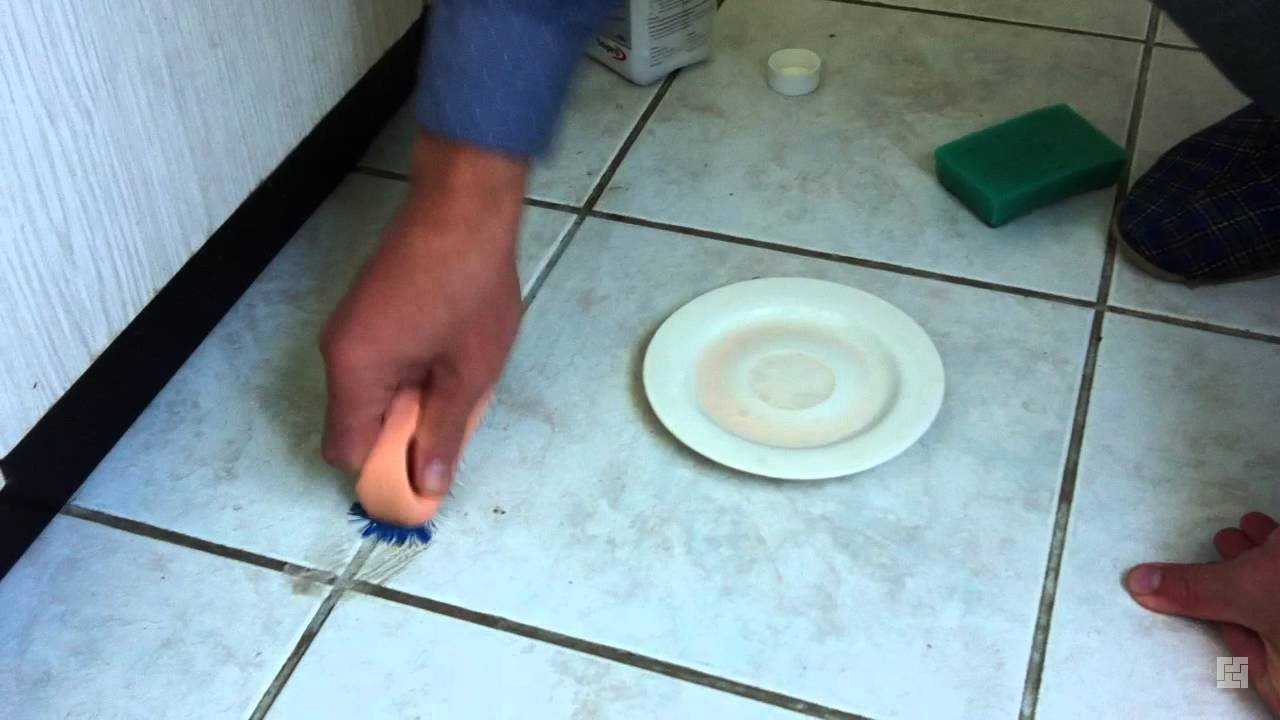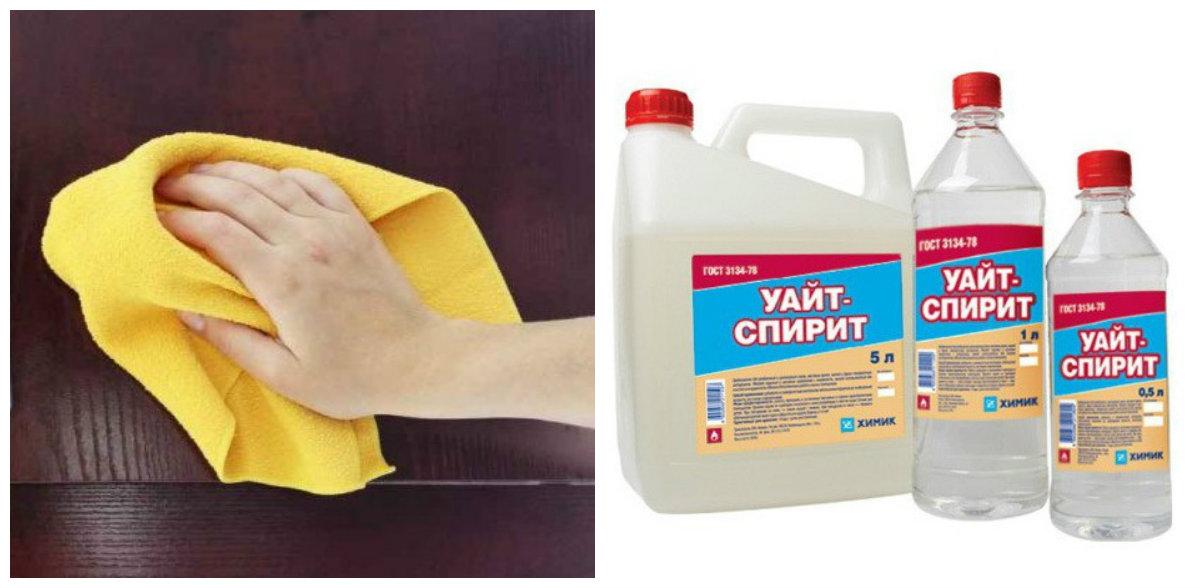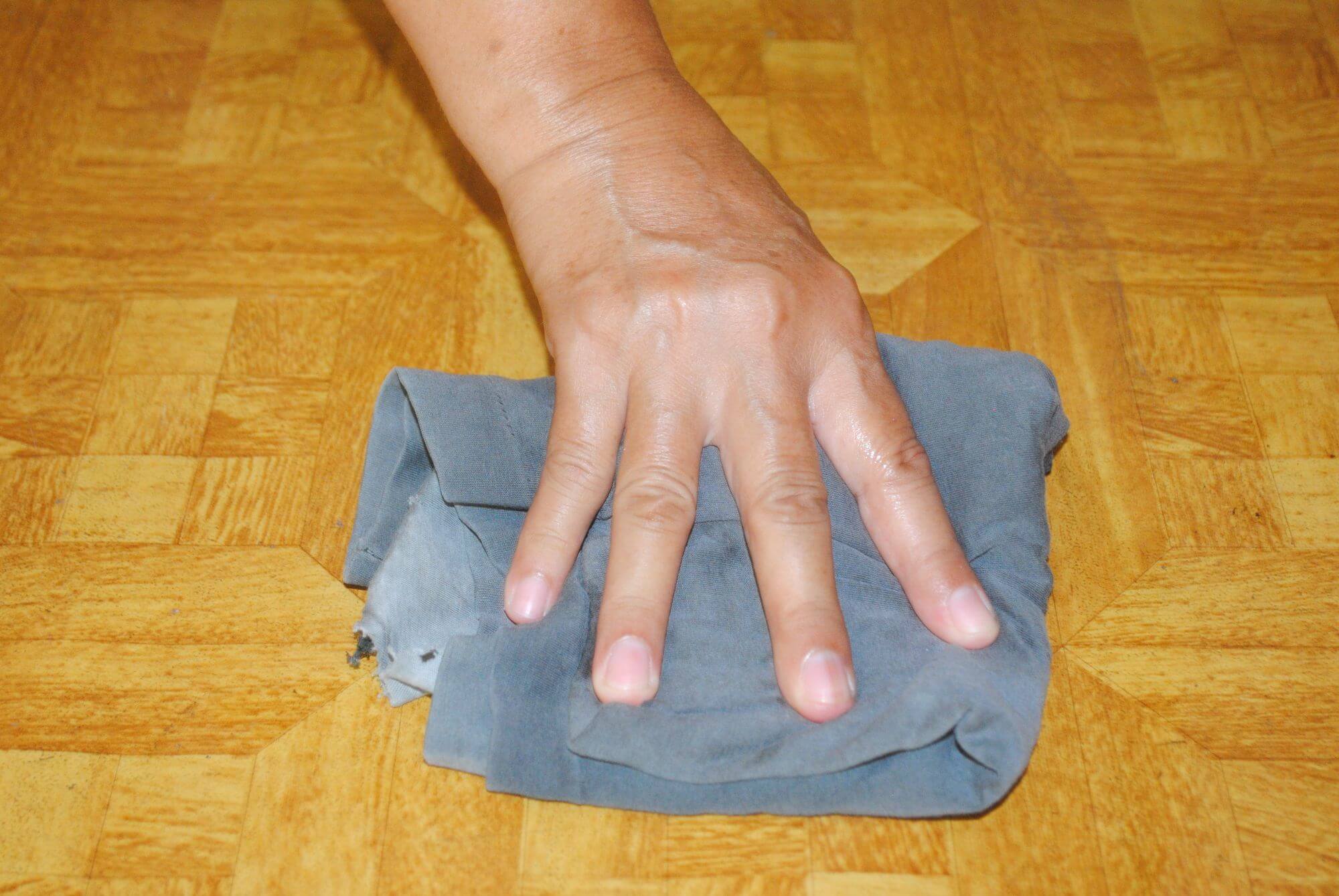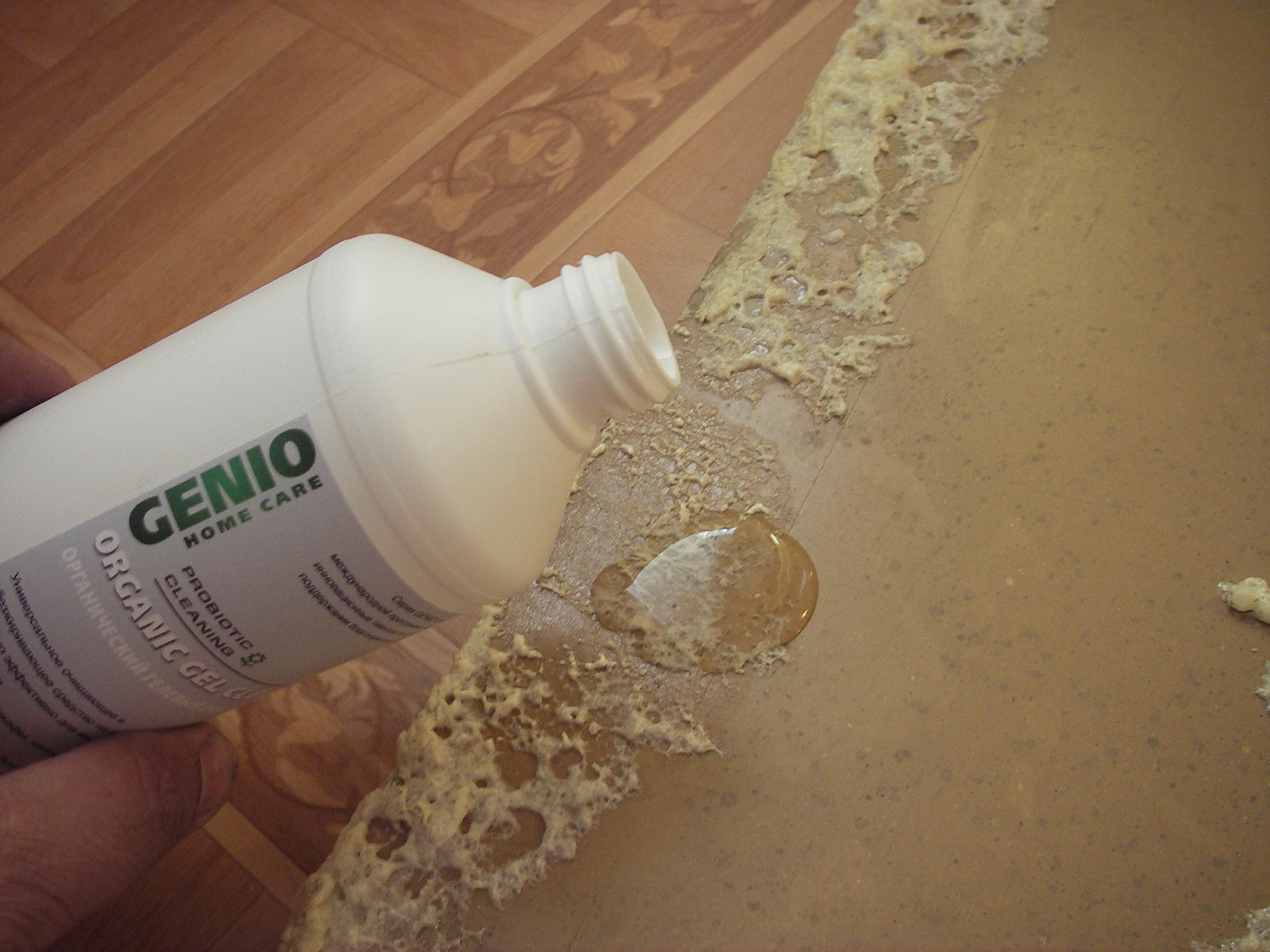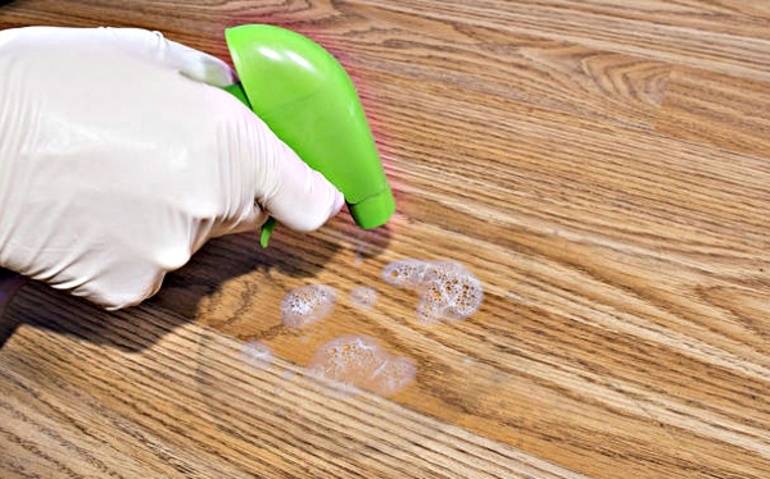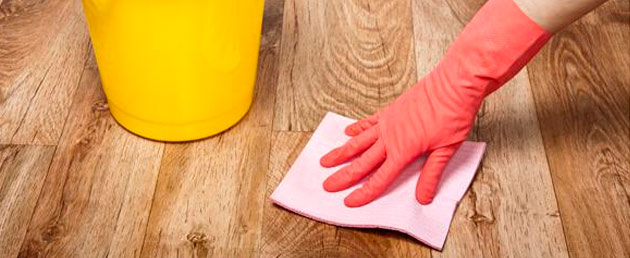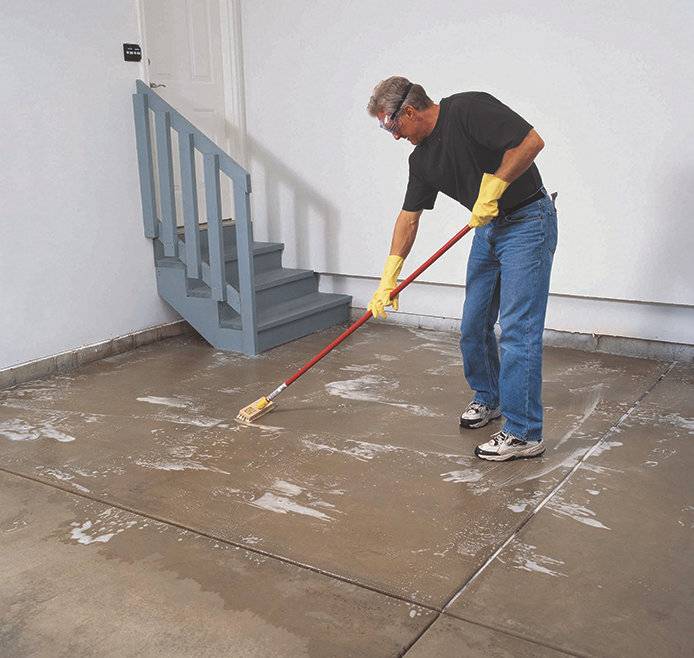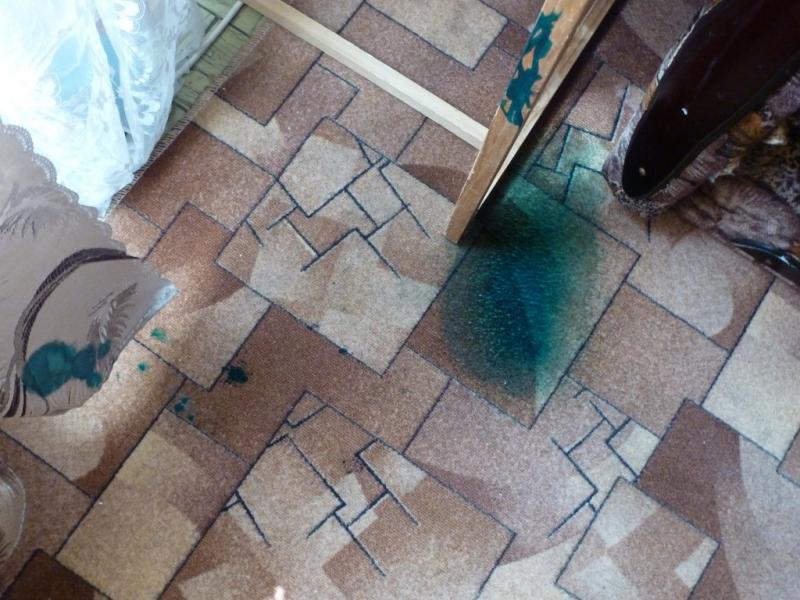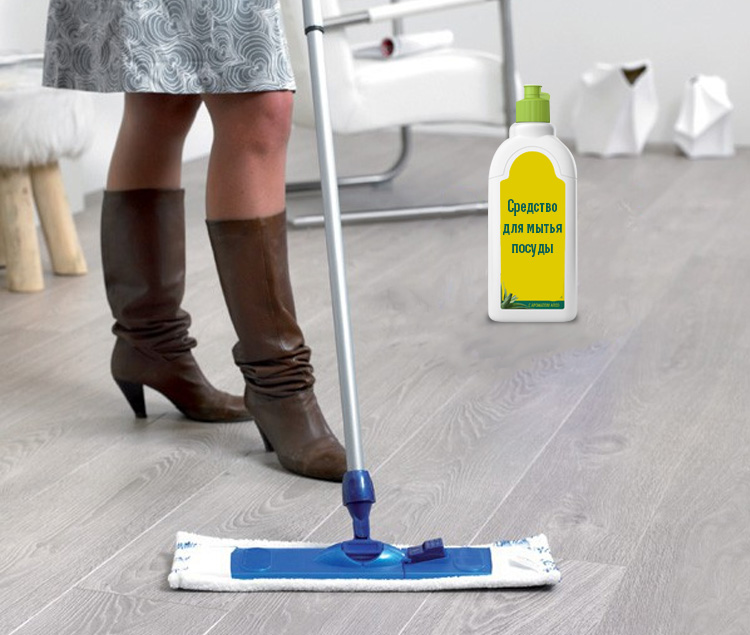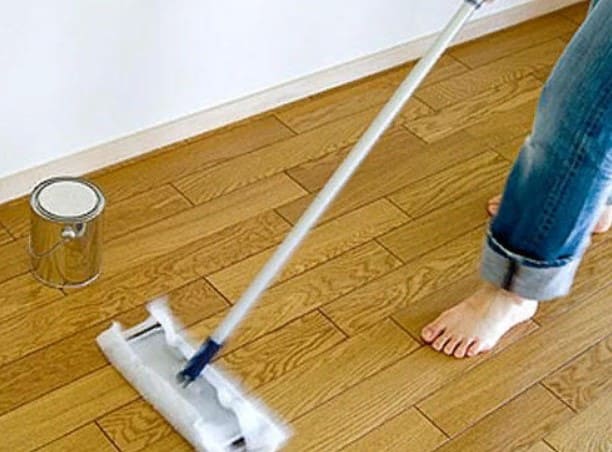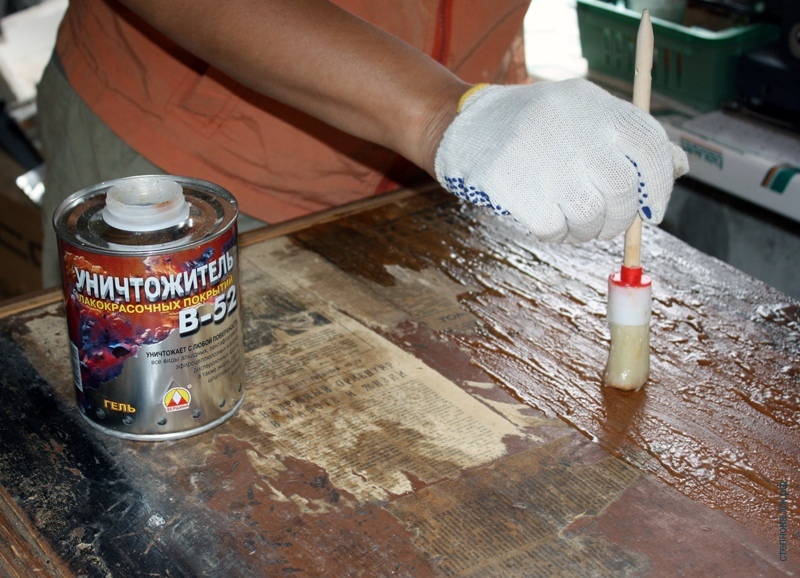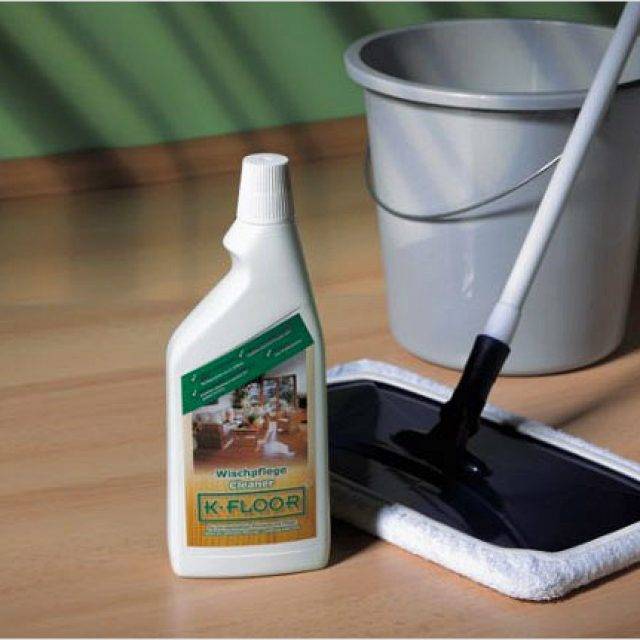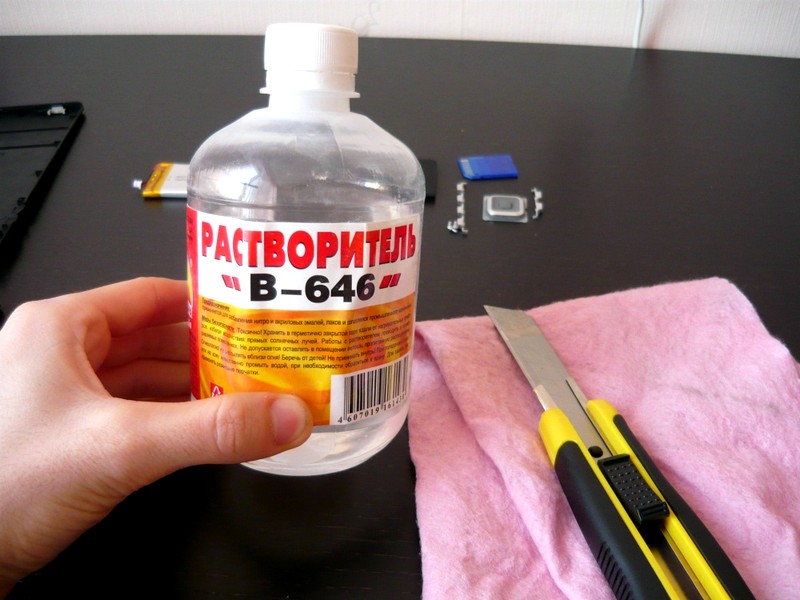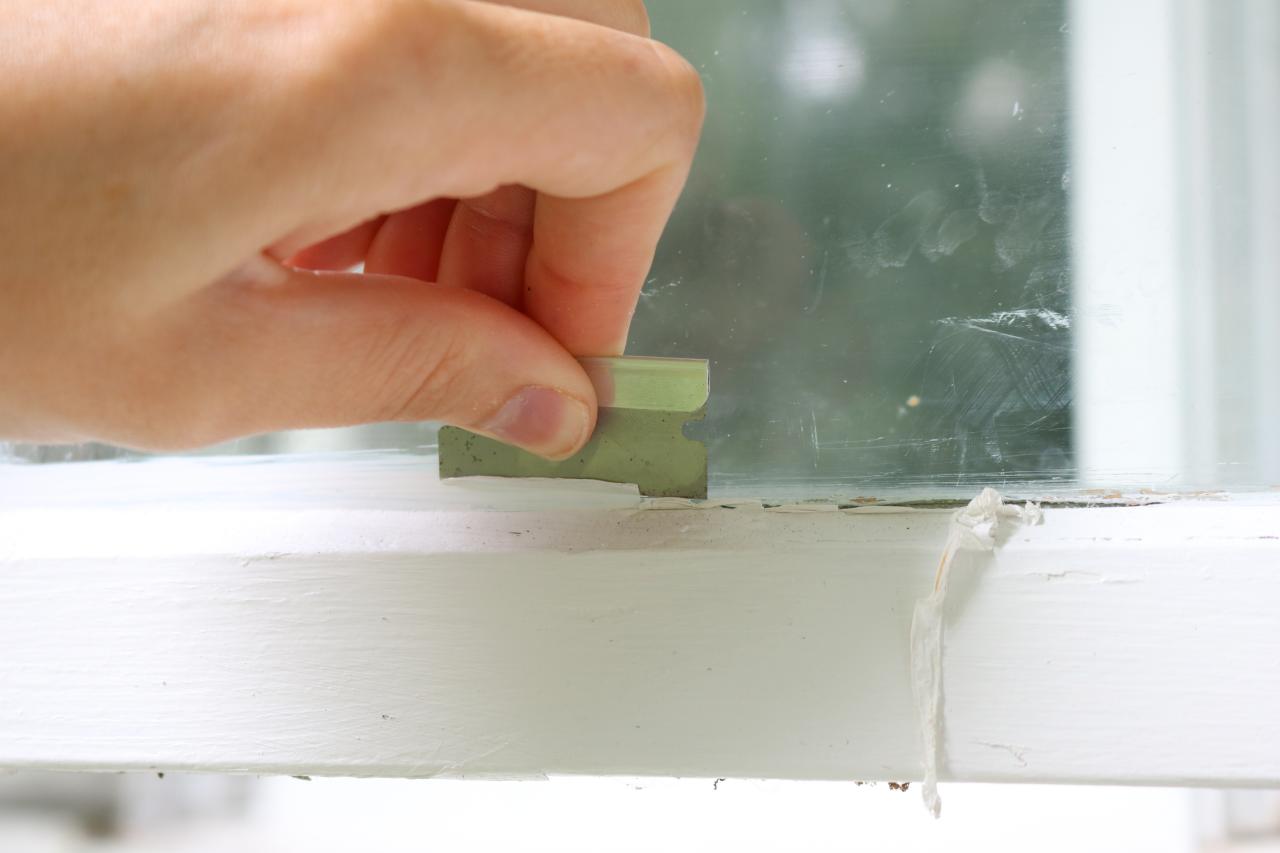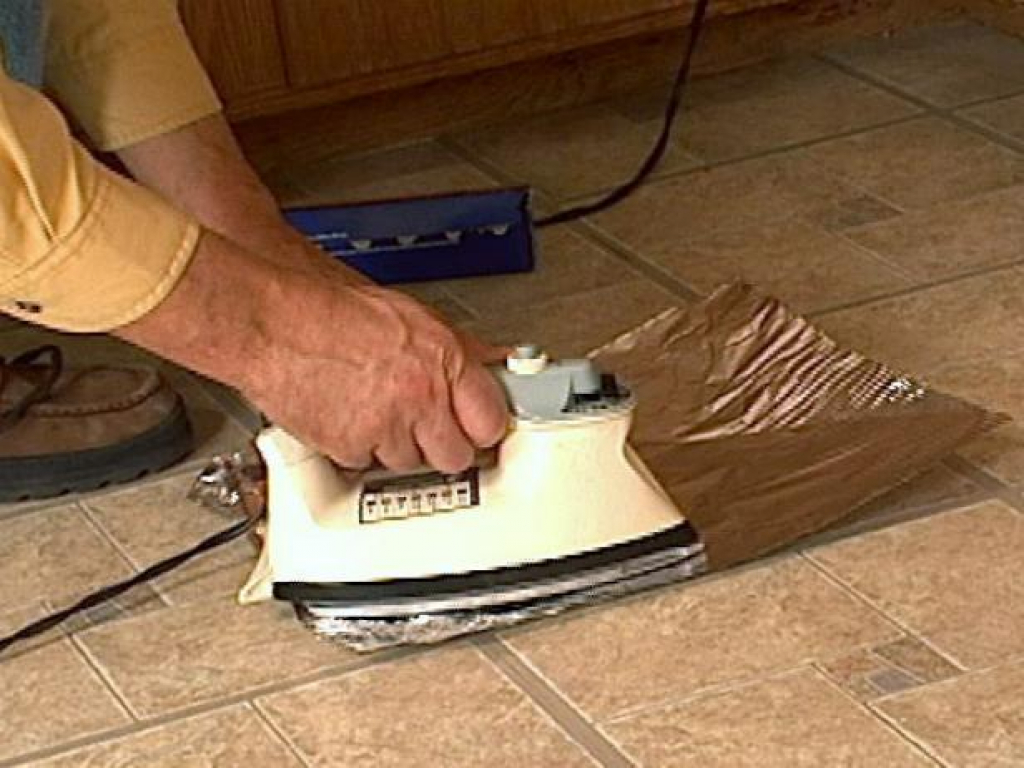Removing primer stains from all kinds of surfaces
So, after a while you found soil spots on linoleum or tiles, which you did not pay attention to during the repair. What to do?
The main methods of cleaning different materials are not universal and each specific case must be approached selectively. But remember that in the end, with diligence, you can clean any surface.
Glass
To get started, you will need to get up-to-date tools, dissolving agents, and rags.
If the stain is more or less fresh, then you can wet the sponge in plain water and gently wipe off the stain. If the substance is already dry, lubricate it with the same primer and allow the surface to absorb moisture. The stain will swell and can be wiped off with a damp cloth. If the stain is so dry that this method does not help, use a razor blade. It will help remove any remaining dirt. Move it in one direction without excessive pressure so that there are no scratches on the glass.
Particularly heavy stains can be removed with glass cleaner. For example, Dopomat or Hodrupa. These are concentrates with low foaming, which are diluted in a ratio of 10 ml to 1 liter of cold water.
It is also helpful to have an abrasive sponge, a T-shaped scraper, detergent, and the like. All this can be a great help in the fight against soil stains on the windows.
Tile
How to wash off soil contamination from tiles or tiles? Experts recommend that, if possible, first try one of our proposed methods on a sample of ceramic tiles that decorate your floor or wall. This makes it easier to find the best option for removing the primer.
To get the job done, you need the following tools and products: tile cleaners, baking soda, scraper, vinegar essence, rags.
If the soil is dry, the stain can be removed with the same material. The stain soaked in the primer will soften and swell, then it can be wiped off with a regular rag. At the end, the place must be treated with an abrasive sponge dipped in water. The stains are rubbed off gradually, so do not be upset if it did not happen instantly.
 Moistened and already swollen spots can be wiped off the tile with any rag
Moistened and already swollen spots can be wiped off the tile with any rag
If the dirt is so old that it cannot be wiped off with water and a cloth, you can use a scraper. It is purchased at a hardware store. Such a tool helps to remove the remains of the primer from the tiles, cutting them off in small pieces. Pre-moisten the stain with water, and then use a scraper to cut it off with a scraper at a thirty-degree angle.
Next, take a detergent and a sponge to remove small particles of soil that can cause damage to the tile in the future.
Linoleum
It is better to wipe the fresh stain from the primer off the linoleum as quickly as possible. If this does not happen, wet the contamination with water and additionally cover with a wet cloth. The stain should soften in two to three hours. It can be wiped off with an abrasive sponge and then wiped dry with a cloth.
Plastic
Vinegar essence is a wonderful option for quickly and easily cleaning plastic surfaces from the remains of the primer. However, remember that in this case it is important to observe precautions, because the vinegar essence, evaporating, releases harmful substances into the atmosphere. For this reason, you need to work in overalls, gloves and a mask. And in the residential premises itself, you will need to organize good ventilation.
And in the residential premises itself, you will need to organize good ventilation.
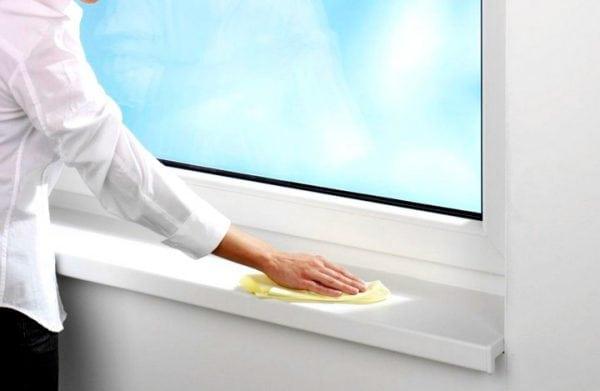 Do not use aggressive agents to remove the primer from plastic
Do not use aggressive agents to remove the primer from plastic
From a plastic surface (for example, from a window sill or countertop), soil stains cannot be removed with acids, otherwise it will simply melt.
Primer mix is highly corrosive and will leave permanent stains if not addressed right away. Nevertheless, if you see the stain in time and wipe it off correctly, you can save any surface from contamination.
Preliminary processing
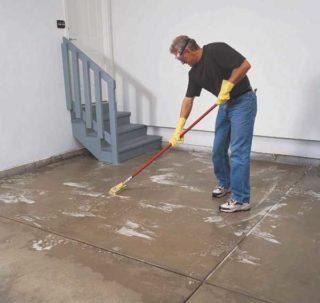 In order to wash the primer, it must be thoroughly moistened
In order to wash the primer, it must be thoroughly moistened
To wash any building compound that has just fallen on the floor, you will need a piece of cotton rags. It easily absorbs liquids, so you just need to wipe the dirty area with it, and then rinse off the remains with water.
If the primer is dry, before proceeding with the removal, you must try to soak it as much as possible. Here are some ways to do this:
- The contaminated area is covered with wet rags and left for 2-3 hours. The drying matter is periodically changed so that the dried spots are constantly exposed to moisture.
- The acrylic primer is soaked by pouring boiling water over it.
- The same primer is applied to the contaminated area. It always contains a solvent. Under its influence, the dried stain will become soft and it will be easier to scrub off with scrapers and spatulas. The main thing is not to stay with cleaning until a new layer begins to set.
The next step in cleaning should be mechanical removal of most of the adhering primer. A well-soaked composition is best cleaned with plastic spatulas. Harder areas are metal with sharp edges. Tiles with a grooved surface - hard brushes and sponges.
How to clean the tiles on the floor after renovation
Method 1
The following homemade whitening product will whiten the seams between tiles, as well as freshen the tiles themselves:
- Prepare 10 glasses of water in a sufficiently deep container, as the mixture may react and rise for a while;
- Add ½ cup baking soda and 1/3 cup lemon juice to it;
- Pour in ¼ cup vinegar;
- Mix, put on gloves and scrub the tile floor with the solution.
Method 2
Ideally cleans the tiles after repair from dust, dirt, glue, as well as contaminated over time, using the Aist Sanox gel.
- Put on gloves, apply the gel to the sponge, and then to the tile;
- The action of the product is instant, so you can rinse it off almost immediately with clean water and enjoy the result.
Method 3
It will not be difficult to wash off the construction dust from the tiles. Water with lemon or vinegar, glass cleaner, and ordinary soapy water will perfectly clean and give shine. But with a glue solution, especially a dried one, it is more difficult to cope. First, it should be softened.
- Moisten the glue spots on the tile with a mixture of water and vinegar, or water and ammonia (acetone is also used, having previously checked it in a small area to avoid the risk of damage to the tile);
- The softened adhesive can be scraped off with a hard sponge or scraper.
Method 4
The cured primer is washed off with acetone or you can purchase a special remover that includes a solvent. The principle of operation is similar to the previous version.
- Apply thinner or acetone to primer stains;
- Once they have softened, remove them with a glass scraper and blade.
Method 5
You can get rid of acrylic primer from tiles in this way:
- Wet a towel and lay it on the stained surface;
- Maintain moisture for several hours by spraying with water;
- As soon as the soil swells, it can be carefully cleaned with pemolux and washed off with clean water.
Method 6
Paint stains on the tiles are excellently removed by such products as: "Mole", "Pufas Abbeizer" or ordinary acetone. Alternatively, liquid glass. When it turns into a film, it can easily peel off along with the paint.
Method 7
Residual cement on tiles can be removed with Atlas Szop, Milizid, also an effective mixture of vinegar, citric acid and Domestos.
Any contamination is much easier to remove immediately after it hits the tile, before it hardens.
Method 8
If you are not sure how to clean grout from tiles on the floor, experiment with the following methods and products, considering that smooth glazed tiles can be cleaned well with a dry cloth, and then with water and detergent. Matt glazed - with acidic substance.
- Washes the grout with a mixture of oxalic acid and water;
- Table vinegar, can be diluted with water;
- Acidic substances will help, for example, "Deterdek", "Litoclean";
- Cinderella cleaning agent;
- You should try gasoline, acetone, white spirit.
How to clean dry primer
It is more difficult to remove dried dirt. There are effective ways to wash the surface from the primer: mechanical action, the use of chemicals and folk cleaning methods.
Mechanically
Not suitable for glossy, acrylic tiles. The danger lies in the possibility of damaging the top layer of the tile, paint. The method is used for a matte surface. For mechanical cleaning, you will need a metal scraper or a sharp blade.
To wash the coating, you need to wet the primer with water or soapy water and leave for 6 hours.
The scraper or blade should be moved smoothly, tilted at an angle of 30-40 degrees, and rubbed over the stain. When the main layer comes off, you need to wash off the remaining primer from the tiles with a sponge soaked in an abrasive cleaner with surfactants: sodium salt, metasilicic acid, baking soda, sodium tripolyphosphate, chlorine, pumice, chalk chips and other disinfectants.
Abrasive means scrubbing. It is recommended to choose foods with a soft composition so as not to leave scratches on the tiles. Softness depends on the size of the particles. Large ones are considered coarser, small ones - soft. Do not rub hard, traces will remain. You can wipe off any remaining primer with a dry cloth or paper.
By chemical means
Before starting the procedure, you must wear rubber gloves to protect the skin. Otherwise, you may get a chemical burn. Acetone is used, a flammable liquid that is contained in the paint. To clean the tiles, you need to apply the product to a sponge and wipe the contaminated area 2-3 times.
The solvent works effectively against stains by breaking down the structure of the primer.
Removal takes 5-7 minutes. The disadvantage is that acetone leaves a mark, erases paint, deteriorates the appearance of the tile. The recommended tool is ATLAS SZOP. The product is considered universal, suitable for tiles and other surfaces - glass, wood, clinker. To wash the coating, experts advise using alkali, toluene, turpentine. The compositions are similar to acetone, they act softer.
Folk methods
You can clean it by resorting to folk methods. To wash the hardened primer from the tile, you need to dilute the baking soda in water in equal proportions and wipe the stained area with a moistened sponge. There are no chemical compounds, the appearance of the tile does not deteriorate.
To wash the tiles from the frozen solution, use vinegar. The liquid poses a danger to human health, the vapors emitted can burn the lungs, the highly concentrated product can damage the skin of the hands. Before using it, you must wear a mask, rubber gloves to avoid consequences.
Acetic acid diluted with water will help remove stains.
The solution should be gently applied to a rag. You need to attach the cloth to the place of contamination and hold for 10 minutes. When the primer starts to soften, rub it vigorously.
You can wash off the remnants with warm water.
White spirit is diluted with water and applied to the cured primer.Experts recommend performing the procedure using a spray bottle. The liquid will be evenly distributed. If the solution gets on the wall, it will worsen the condition of the paint. Residues from the tile can be wiped off with a scraper.
Acetic acid diluted in water breaks down the wall decoration material. Citric acid can leave marks on tiles. The product is recommended for matte tiles.
How to prevent soil stains on walls and floors
Do not think that painting art is an uncomplicated business. Often, even experienced builders stain linoleum or tiles on the floor with a primer, as well as the glass of a window or window sill. And if such stains are not washed off instantly, then over time they turn into a rather difficult problem.
So that you do not have such difficulties after repair in a country cottage or city apartment, you can try to protect the surfaces as much as possible from the risk of staining them with a primer. How to do it?
 Plain cellophane is a good protection against unnecessary stains
Plain cellophane is a good protection against unnecessary stains
Just adhere to the following rules while performing all repair work inside a country cottage or city apartment:
- In order to prevent the solution from getting on all sorts of surfaces that do not need priming, you need to completely cover them with cellophane. Be sure to glue the joints with ordinary stationery tape;
- To protect yourself from allergic reactions and other health-related complications, be sure to carry out all work in overalls and a mask. Also, regularly ventilate the room, because the soil has a pungent smell.
Simple ways to remove dried primer
It is possible to wash a deep penetration primer that has dried up in several ways - using a special agent (solvent) or mechanical scrubbing. Each method is suitable for different types of primers and other materials. For this reason, especially in the case of solvents, read the instructions carefully to avoid scratching the glass or other surface due to the use of an unsuitable product.
Special solvents
Not all solvents are suitable for glass, wood (frames, doors), plastic. When purchasing them, consult a specialist or try the effect of the substance on a small area of the surface. A large percentage of solvents are sold in the form of solutions or gels, their active ingredient is acids. Therefore, be careful when removing dirt from clothing! They dissolve the top coat of the primer, penetrate into it, facilitating subsequent removal. These products should not be used in the sun or at high temperatures - too high temperatures reduce the effectiveness of the solvent.
Always strictly follow the instructions provided with the specific substance. Some guidelines apply to all solvents:
- Apply the product with a brush or spatula (according to its consistency) on the initial layer for 15 hours.
- After loosening the primer, remove it with a spatula.
- If the primer is thick or dry, one application will not be enough. You will have to repeat the procedure, sometimes even several times.
- After finishing cleaning, wash the glass (or other surface).
- Remember you are using a chemical. When handling solvents, protect your hands with gloves, eyes with goggles or a face shield.
The scraper is the most efficient tool
The main way to remove primer is to use a scraper. Using this method, you can wipe off dirt from tiles, wood, porcelain stoneware, glass surfaces.
After finishing cleaning, residues can be removed with a suitable cleaning agent.
Using popular remedies
Folk councils recommend adding vinegars to warm water, which is used to wash dirty surfaces. This prevents smearing of the primer, the formation of stains that are difficult to remove.But, if you completely covered the surfaces before starting work, the only stains will be present on window and door frames, window sills. These stains can be easily cleaned.
Vinegar is an excellent helper in case you need to clean the floor, it prevents color blurring, removes stains. By the way, before you start cleaning the floor, check the cleanliness of the soles of your shoes, otherwise you will have to repeat the process.
Causes of primer contamination of windows and sills
 During repair work, the primer may accidentally get on the glass.
During repair work, the primer may accidentally get on the glass.
Painting works only at first glance seem simple and uncomplicated. In fact, this is real art. You need to know how to create a durable finish and provide a strong adhesion of several layers of finishing materials. If you paint the walls yourself, you will hardly be able to do everything neatly at once. Often, when applying a primer, the solution splashes. Its drops fall on the glass and on the windowsill. You can safely remove them if you know how to clean the windows after repair from the primer. Initially, you need to arm yourself with tools and substances that can dissolve dried mortar. For work you may need:
- pure water;
- white alcohol-based solvents;
- cleaning and detergents;
- vinegar essence;
- washcloth;
- rag.
How to remove construction dust
The renovation is completed, but the apartment or house is covered with a layer of fine, omnipresent dust. This picture is familiar to many. How to remove construction dust? Let's say right away that you will have to clean up more than once. You will need a good spray bottle and a powerful vacuum cleaner, a bucket and many, many rags. It is better to use a construction vacuum cleaner with a long hose and a telescopic nozzle. It is also possible for households, but he, most likely, will not survive such a load. It may need to be thrown away after cleaning, as fine dust clogs the engine and burns it out.
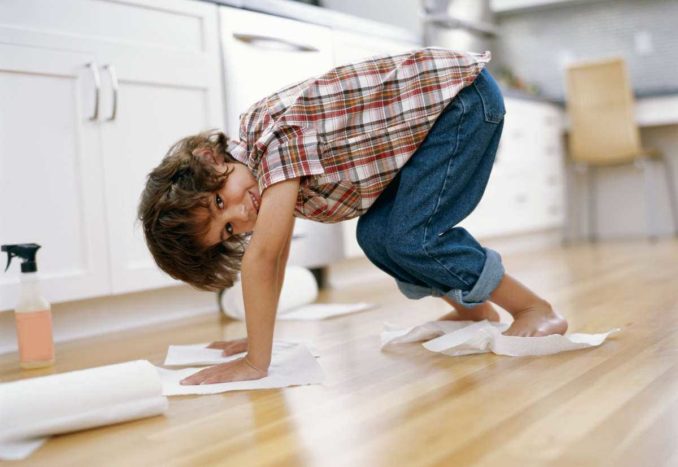 It's good when there are helpers
It's good when there are helpers
If you have a humidifier with an ionizer, you can adapt it instead of a spray gun. But it must be left in every room for a couple of hours. Too long if there are several cleaning rooms.
Cleaning the floor from dust
Close the windows / doors in the apartment, then you can start cleaning construction dust. If the ventilation works well, you can cover it while cleaning. Let's say right away that you will have to repeat everything more than once, you need to do cleaning in all rooms, moving from one to another. The technique is as follows:
-
We adjust the spray gun to the finest water dust, spray a certain amount higher into the air. Mist settles, capturing dust particles that are in the air. A damp crust forms on the floor. If there is a significant layer of dust on the floor, it is better to wait until dry and vacuum up.
- We leave the room for at least an hour - so that the water dries up. We make sure that there is no draft that can lift the settled dust into the air.
- The vacuum cleaner is in the next room, and we carry a hose with a nozzle into the room, collect dust with a vacuum cleaner.
- We repeat the "event" until the air becomes relatively clean and there is a minimum of dust on the floor.
Next, you need to wash the floor. If the air has been sufficiently cleaned and after the next vacuum cleaner dusty tornadoes are not carried in the air, you can not spray water dust. We take a lot of water, a lot of rags. We wash the floor. The rag and water should be changed as often as possible. If possible, it is better to rinse the rag in running water every time. You run into the bathroom, of course, but cleaning is more efficient this way. Don't try to wash it completely yet. The main task is to remove the volatile fines. It can be removed only with water and a cloth. If you have a cyclonic washing vacuum cleaner (with a water tank through which air is passed and the sucked-in dust settles in the water), you can adapt it. He copes with the task perfectly - quickly and efficiently.
For information on how to make a cyclone-type aqua filter for a household vacuum cleaner, see the video below.
We remove residues from walls, windows, doors
Then we clean the vacuum cleaner, wash the brush or put on a clean / new one. The second option is preferable. We remove dust from the ceiling and walls with a vacuum cleaner. You can walk several times. Then - again the floor, then - the windows and doors. Do not forget to wipe the top on the door. There is a lot of dust there. When the doors are closed, it is sprayed around the room.
 No expensive cleaning products are needed to clean the floor after renovation
No expensive cleaning products are needed to clean the floor after renovation
After removing dust from all vertical surfaces, we wipe the floor again, often washing a rag. If white stains remain on the doors, windows, add vinegar or citric acid to the water. You can drip some dish detergent. After processing with such a composition, there should be less stains.
How to clean the floor after renovation
While you just wash the floor with water, you get the impression that the dust is simply smeared. White streaks remain all over the floor. When the walls and ceiling have already been cleaned, you can try to clean the floor with better quality. You need to add to the water:
- A little vinegar. Regular, food alcohol - 6-8%. For a bucket of water - half a glass.
- Table salt. In a bucket of warm water with 1/3 cup or so. Stir until dissolved.
-
A couple of tablespoons of vegetable oil.
To get rid of white stains on the floor, you can try all three remedies in turn. Each "additive" - salt and vinegar - works, but somewhere one turns out to be more effective, somewhere else. Depends on the composition of the dust (its source, to be precise). For a faster result, you can immediately use salt and vinegar. They do not interfere with each other. Vinegar has an unpleasant odor and can be substituted with citric acid.
These simple home remedies can help you quickly remove dust from your floor after renovation and get rid of streaks. Basically, as soon as the dust layer on the floor has become very small, salt and vinegar can be added. There will be fewer streaks, but the water needs to be changed frequently. Finally, water with vegetable oil will help to remove white plaque from the floor - linoleum, laminate, tiles. It's so strange, but it works. Check it out. And the floor is non-greasy and non-slip. So, to clean the floor after renovation, you do not need some kind of miracle funds for big money.
Features of different types of cleaning
The cleaning process of the primer depends on the type of primer. In order to choose a means for flushing the material, it is necessary to find out what type was applied to the surface to be treated.
Primers for wallpapering
Before pasting the walls with wallpaper, the surface is covered with a specialized compound. This type of material is easily washed off, especially before it dries. You can remove the remnants of the material with a damp cloth, sponge or washcloth. If the primer has time to harden, it is necessary to pre-moisten the spot where the stains appear, wait for the swelling and then remove the traces with a rag.
Acrylic
Acrylic is easiest to remove from smooth surfaces, including tiles and glass. Having noticed a trace of the material, it is necessary to wipe it with water and, after softening, remove it without using chemical solutions. If dyes were present in the acrylic composition, it is better to use a solvent for processing.
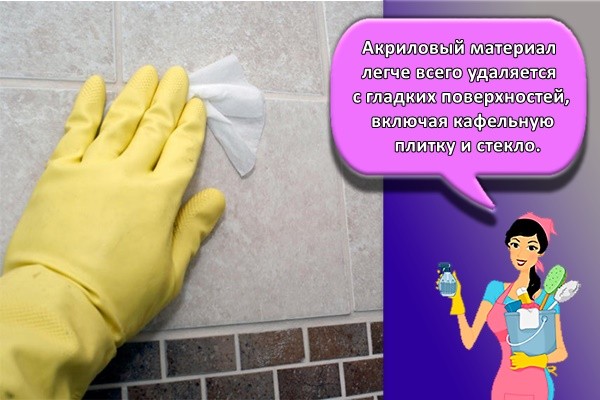
Deep penetration
Upon contact with the surface, deep penetration compounds dry out within 24 hours. If material has not been removed within this time, cleaning will require a chemical solvent treatment. Traces are washed off according to the following scheme:
- moisten the surface with warm water;
- apply a solvent to the pollution;
- after absorbing the solution, wipe the wall with an abrasive sponge;
- Wipe the surface clean with a rag.
Adhesive
An adhesive type primer is designed to improve adhesion between the substrate and finishing materials. Adhesives dry quickly, do not dissolve with water.
Phenolic
The primer, which contains phenols, is intended for impregnation of wooden surfaces. It is possible to clean up traces of phenolic substances using standard solvents.
Selection of a method according to the type of soil
There are several groups of products for cleaning soil stains. In this case, everything will directly depend on the type of primer:
- primer for wallpaper. This mixture is considered the simplest and safest. To do this, the user only needs to moisten the stain and wait until it is completely limp, then rinse off with a sponge;
- acrylic based primers. Such products are also quickly moistened with water, but in this case it will take longer to soak the product. The only exception can be pigmented (colored) products, in this case, the stain will have to be additionally wiped with white alcohol;
- adhesive agents. Almost all adhesive-type soils are characterized by deep penetration into the surface of the stain, so it will be rather difficult to remove them. In this case, it is best to use a scraper first. If this does not work, then you need to moisten the stain with an organic solvent, it will help to significantly soften the top layer and suppress the adhesive effect;
- phenolic primer. It is most often used in wood surface treatment. They can be removed from glass with xylene or solvent. You can also try using white alcohol with a solvent in a one-to-one ratio.

How to wipe off dried stains?
Dried plaster stains should preferably be wiped dry. But if there is a tile on the floor, you should not scratch it so as not to scratch the coating. For cleaning soft coatings, vinegar solutions of different concentrations are used.
If the plaster is difficult to clean, then it is worth purchasing any product with active acids in the composition. For example, Dressing Duck or something similar for cleaning plumbing fixtures. But it is not recommended to wash linoleum or laminate with such means, so as not to spoil the coating.
Attention
Before cleaning the floors, you need to test the product on trimming the material. If it has not changed color, then it is allowed to wash the floors with this product .. When cleaning the room, the windows must be open
Otherwise, there is a risk of inhaling harmful fumes and getting poisoned.
When cleaning the room, the windows must be open. Otherwise, there is a risk of inhaling harmful fumes and getting poisoned.
From windows, including plastic
 Before you start cleaning windows, you need to clean the window frames:
Before you start cleaning windows, you need to clean the window frames:
- Plaster traces are abundantly moistened with water.
- When the remnants of the material are soaked, it can be easily removed with a spatula.
After removing the bulk of the plaster, start washing the windows with soapy water. For cooking, you need to mix 1 tbsp in 3 liters of warm water. l. dishwashing detergents. A cloth napkin is moistened in the solution, the windows are wiped with it.
If folk remedies have not been able to wash stubborn dirt, you need to use the store. For example, Mister Proper, Sanita, Domestos will do.
Off the floor
It can be problematic to clean the floor, whatever it may be, from whitewashing and plaster, the first time, so cleaning is carried out several times:
- First, the floor is washed with ordinary soapy water, for the preparation of which water is mixed with soap chips. The solution is applied to the floor for 10 minutes and then a suitable coating agent is used. At this stage of cleaning, every effort should be made to wipe off the dirt.
- After cleaning, the floor is washed again using clean water.
Important
For each stage of washing, use a different rag so as not to smear dirt on the surface.
From the door
Before you start scrubbing the plaster from the surface of the door, it is important to know what material to deal with. Most often, doors are made from:
- wood;
- MDF;
- become;
- plastic.
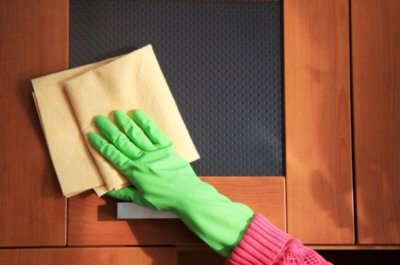 Some surfaces may not withstand contact with strong detergents.
Some surfaces may not withstand contact with strong detergents.
- If the door is made of wood or MDF, the plaster can be removed with a sponge, water and a trowel. First, it is moistened with water, and then the soaked mass is removed with a sponge. For stubborn dirt, use a spatula or blade.
- Fine-grained sandpaper is used for metal doors.
Difficult stains are moistened with water and then cleaned with a brush and soapy water. Sometimes, after such manipulations, the door is again varnished.
From tiles
It is believed that it is easiest to remove dirt from a tiled floor:
- You can use iron scourers to scrape off the plaster.
- To remove the remaining dirt, they resort to using toilet cleaners. About 2 liters of water are mixed with 50 ml of the product and the solution is applied to the traces of the plaster. After 10 minutes, you can try rubbing off the stains.
- If the traces are poorly wiped off, the concentration of the solution is increased by adding another 50 ml of the product. As soon as the stains are removed, the tiles are washed again with clean water.
From linoleum
Advice
For washing linoleum from plaster, kerosene, gasoline, ammonia are excluded - not all coatings transfer these substances. Together with dirt, they can dissolve the protective coating.
Washing linoleum begins with washing the floors with clean water:
- If there is a lot of dirt on the coating, then soap chips are added to the water.
- If the usual wet cleaning does not work, they resort to using turpentine. They treat the stain, and after a few minutes remove it with a damp cloth.
Common ways to help clean the primer
What remedy can be used to get rid of traces of the treated product? There are no universal remedies, it is necessary to select for each case separately. To do this, you must first check on a small area of the contaminated surface to see the result. It is best to choose a place that is not very noticeable to the human eye.
But the best thing to do is to notice streaks or drops of primer in time and immediately wipe it off with a wet rag. Since after two hours, it will be more difficult to do this, and if it goes through for two weeks (this is the most optimal setting time for the primer), then it will no longer be possible to do something.
If the primer has time to dry out a little, you need to moisten the stains with the same liquid and quickly wipe dry. Then wipe the area with a wet cloth. You can also wet rags, put on the places where the spilled primer is located and leave for several hours so that it swells, and begins to separate well and remove with an abrasive sponge, periodically moistening it in water. In order for the tile to remain intact, you do not need to try to scrub it off immediately.
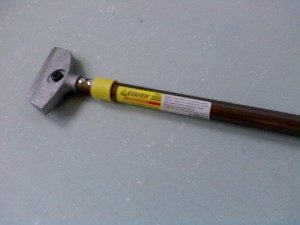 The primer can be removed from glass and other smooth objects with a special scraper. This item is similar to a regular disposable razor. It has a replaceable blade and a handle. Pre-soak the stains with water, and then gently clean off with a scraper, holding it at an angle of 45 degrees. After the procedure, it is necessary to wash off the residues using a cleaning agent.
The primer can be removed from glass and other smooth objects with a special scraper. This item is similar to a regular disposable razor. It has a replaceable blade and a handle. Pre-soak the stains with water, and then gently clean off with a scraper, holding it at an angle of 45 degrees. After the procedure, it is necessary to wash off the residues using a cleaning agent.
You can remove the primer from plastic windows with a foam cleaner and alcohol. Contaminated areas should be moistened with these products. And then clean it off with the same scraper.
The primer can be removed from the glass unit using Diplomat and Holdup.
These are good liquids, but you need to use them very carefully so as not to leave streaks on the glass or other damage. There is also a tool called ATLAS SZOP
which can remove not only the primer, but easily cope with old gypsum residues or cement. They can easily clean ceramic, stone tiles, chrome and lacquered surfaces. Perfectly cleans sanitary ware and materials made of high quality steel. However, acid-unstable materials cannot be treated with such a product. In this case, it is better to use paint remover or solvents.
If the tile is made of acid-resistant materials, then a sanitary ware or Mr. Muscle for windows is suitable for cleaning the primer on it. It is an effective substance.If the surface is not smooth, but has roughness, then additionally you need to use a hard washcloth to wipe off the dirt. After that, you need to take a wet rag, a large amount of baking soda and wipe off any traces of the primer.
Wash basins, toilets and heavily splattered window sills, tiles can be salvaged with vinegar essence. But before that you need to protect your hands and airways. It is best to wear gloves, a gas mask or a mask with high-quality filters if you have one.
During repairs, you can not only spray the floor with a primer, but also leave traces of grout on the ceramic tiles. How to be?
How to wash grout from tiles
 Such contamination is especially noticeable on light-colored tiles with a bright grout. To begin with, I would like to warn you that it is possible to take preventive measures to avoid such a problem. There are such special products on sale that are applied to the tile a few hours before starting work with grouting. They form a protective layer and after finishing work, with one light movement of the hand, you can remove excess grout from the surface.
Such contamination is especially noticeable on light-colored tiles with a bright grout. To begin with, I would like to warn you that it is possible to take preventive measures to avoid such a problem. There are such special products on sale that are applied to the tile a few hours before starting work with grouting. They form a protective layer and after finishing work, with one light movement of the hand, you can remove excess grout from the surface.
The grout does not take long to fully harden. This takes about half an hour. And in order to remove the remnants of the trowel in time, you only need water, a bucket, a rag or a sponge. Gently, not pressing the rags too hard, so as not to damage the seams themselves, wipe the surface in a circular motion. The water needs to be changed often, and rinse the sponge in running water more often. After cleaning, the seams need to dry for about thirty minutes.
But what to do if traces of cement are visible on the tiles.

